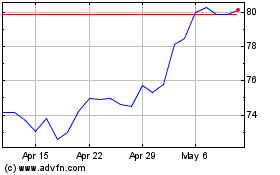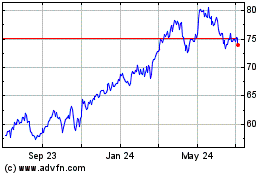By Leslie Scism
American International Group Inc. said Chief Executive Peter
Hancock will resign after two years at the helm of the giant
insurance conglomerate, following a major setback in its turnaround
plan.
The board, which met at the company's headquarters Wednesday,
was expected to debate whether to replace Mr. Hancock in the
aftermath of the company's $3.04 billion fourth-quarter loss, The
Wall Street Journal reported late last month.
The board will launch a search for a replacement for Mr.
Hancock, who will remain CEO until his successor is named. AIG's
shares edged up 0.6%.
Mr. Hancock, who is 58 years old, has run AIG since September
2014. The former J.P. Morgan banker was first hired by AIG in 2010
to oversee exposure to risk, among other matters, and in 2011 was
promoted to run the global property-casualty unit, setting him up
as the heir apparent to then-CEO Robert Benmosche . AIG also has a
large U.S. life-insurance business.
But Wall Street analysts have recently cited a credibility gap
after AIG posted an unexpectedly large fourth-quarter reserve-boost
of $5.6 billion. The move marked one of AIG's worst reports since
the U.S. government bailed it out during the financial crisis. The
reserve charge included policies sold to corporate clients while
Mr. Hancock ran the property-casualty unit and other policies
issued as recently as 2015.
Mr. Hancock's departure marks a win for activist investor Carl
Icahn, who had called for a new leader at AIG in late 2015, before
reaching an agreement with the insurer in which a representative
joined the board.
In response to Thursday's announcement, Mr. Icahn tweeted, "We
fully support the actions taken today by the board of AIG."
In the wake of last month's disappointing results, some analysts
had even begun floating names of possible replacement candidates.
Some emphasized the company may need to recruit someone with deep
insurance experience, which Mr. Hancock lacked before joining
AIG.
AIG shares fell 9% on the Feb. 14 announcement of the poor
fourth-quarter results, and additional bad news the next day:
lowered targets for improving two closely watched profit
measures.
Mr. Hancock had been seeking to bring AIG's performance in line
with the best of its peers by the end of 2017, working with a
timetable he and the board announced in January 2016. That
timetable was worked up amid the calls in late 2015 by Mr. Icahn
and billionaire investor John Paulson for a breakup of the
company.
Those pledges in the timetable were key in the activists'
decision to pass on a board fight last year, and last spring Mr.
Paulson joined the board alongside Mr. Icahn's representative,
Samuel Merksamer.
AIG's performance woes date back to its near collapse into
bankruptcy court in 2008, when it was rescued with a nearly $185
billion federal bailout. Over the next several years, AIG would
sometimes undercut rivals on price as a way to keep customers from
fleeing, according to managers of numerous other insurers. That set
the stage for losses on various types of long-term liability
policies that wouldn't show up for years.
Meanwhile, in its eagerness to repay taxpayers, AIG sold off
some of its most profitable units. The firm repaid its bailout in
full in 2012.
Among the most glaring of AIG's weaknesses since the crisis has
been a below-industry-average return on equity. Return on equity is
a closely watched financial metric reflecting profits earned
against capital invested in the business. Back in 2015 when Messrs.
Icahn and Paulson began agitating, AIG's return on equity stood at
roughly 8%, below the 13% to 15% notched by some rivals, such as
Travelers Cos. and Chubb Ltd.
The measure turned negative in 2016, thanks to the giant $5.6
billion reserve boosting in the fourth quarter.
Over the past year, Mr. Hancock's team has been selling
operations and assets to satisfy activists' calls for a
more-streamlined, better-focused company. Among such moves, Mr.
Hancock sold its growing and profitable U.S. mortgage-insurance
business and arranged a deal under which its continues to benefit
from a slice of the unit's profits.
AIG also promised investors last year that it would return $25
billion to shareholders by this year's end, through stock-buyback
programs and dividends. Between January 2016 through early this
month, it had returned $14.3 billion.
At the same time, Mr. Hancock has spent heavily to upgrade the
company's information-technology systems, which had been neglected
during the crisis years.
Mr. Hancock's departure follows the exit of Philip Fasano, AIG's
chief information officer since 2014. He agreed to depart by mutual
agreement to pursue outside opportunities, according to a memo sent
earlier this week to employees. AIG named Chief Auditor Martha
Gallo as Mr. Fasano's replacement, effective immediately, and said
it plans to name a new chief auditor soon.
Information technology is more important at insurance companies
than in some other industries because insurers learn about the
cause of claims and cost trends through such information
collection.
Mr. Hancock was born in London and grew up in Hong Kong, where
his father worked at a Canadian insurer.
He attended England's Oxford University and spent most of his
career in finance, rising up the ranks at J.P. Morgan over two
decades to run its global fixed-income business before becoming the
company's chief financial officer.
In an odd twist, he established a "global derivatives group"
during his career at J.P. Morgan, similar to the now-defunct AIG
financial-products unit that used a type of credit derivative in
the 2000s to make massive, and ultimately failed, bets on the
housing market.
In hiring Mr. Hancock in 2010, AIG noted that his expertise with
financial products would help with its recovery.
David Benoit contributed to this article.
Write to Leslie Scism at leslie.scism@wsj.com
(END) Dow Jones Newswires
March 09, 2017 11:30 ET (16:30 GMT)
Copyright (c) 2017 Dow Jones & Company, Inc.
American (NYSE:AIG)
Historical Stock Chart
From Mar 2024 to Apr 2024

American (NYSE:AIG)
Historical Stock Chart
From Apr 2023 to Apr 2024
